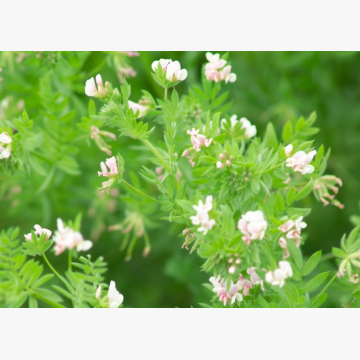Category: Fodder grasses and legumes
FOR CONSULTATIONS APPLY TO:
Commercial director
Lina Smalskienė
tel. +370 618 02 551
e-mail linak@agrolitpa.lt
Sales manager
Tautvydas Kliučininkas
tel. +370 681 35 093
e-mail tautvydask@agrolitpa.lt
Sales manager
Eglė Petkevičienė
tel. +370 626 95 458
e-mail eglep@agrolitpa.lt
Sales manager
Kotryna Nakrošytė
tel.: +370 601 39 282
e-mail kotryna@agrolitpa.lt
Serradella
Ornithopus sativus Broth.
Small annual semi-erect herb adapted to moist sandy soils and cooler climates
- Persists well under continuous grazing
- Very well suited for green manure on the sandier soils
- Tolerates infertile, acid soils
- Does not tolerate droughts
- Flowers for a long period
- May be sown alone or included as a component of a temperate grass (ryegrass, fescue) and legume (clover) pasture mixture
- Suits for sheep and cattle
- The green fodder and hay of serradella is almost equal to clover in terms of nutrition and protein content
- Perfect for grazing as it tolerates trampling well and recovers relatively quickly
- High seed yield, seeds can also be used for fodder
- Serradella is undemanding to the soil, but it does not grow well in dry sands and gravels. Tolerates more acidic soils. Fits well in light soils
- When sown pure serradella, it is lodging, so it is better to grow it with oats
- It is recommended to grow after cereal crops
- Tolerates cover-crop well and continues to grow after it is removed, collecting up loose nutrients in the soil (this it is very important in light soils as it prevents nutrients, especially nitrogen, from leaching out of the soil)
- Serradella leaves a large number of nitrogen-rich roots in the soil, thus enriches the soil. The roots reach a depth of up to 5 meters, from where they collect nutrients that other plants cannot reach.
- Serradella produces a lot of nectar, flowers for a long time (about 2 months) and most importantly, they flower in autumn, when there are very few nectareous plants flowering, so serradellas are also appreciated by beekeepers
The varietal parameters may differ from those indicated here when the testing circumstances differ from quondam
Recommended sowing rate when growing pure crop for fodder or green manure: 40-50 kg/ha
Recommended sowing rate when growing with oats for fodder or green manure: 40 kg/ha + 40 kg/ha of oats
UAB „Agrolitpa“
Keravos sreet. 17, Kerava,
LT-38 131 Panevėžys district, LITHUANIA
Enterprise's code 168598128
VAT code LT685981219
Tel. +370 615 11 315
E. mail info@agrolitpa.lt
Keravos sreet. 17, Kerava,
LT-38 131 Panevėžys district, LITHUANIA
Enterprise's code 168598128
VAT code LT685981219
Tel. +370 615 11 315
E. mail info@agrolitpa.lt




.JPG)


